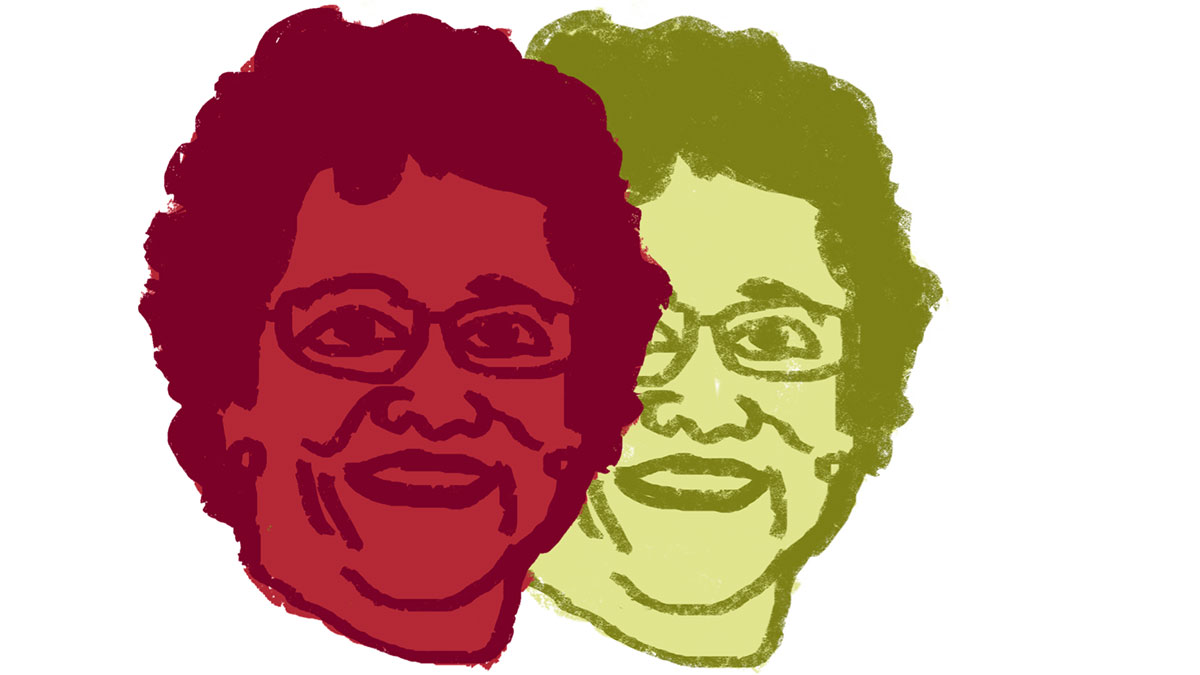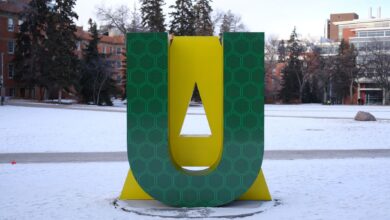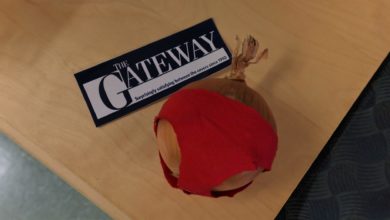Saying Goodbye to Indira
 Alex Patterson
Alex PattersonThe white walls of her office were drab and bare, her desk was clear of sentimental decorations and her dark brown bookshelf, which stretched the entire length of the room, was nearly emptied. All that remained was an 18-inch Dell desktop computer, chair and nameplate on the door.
After 10 years at the helm of the University of Alberta, it was time for Indira Samarasekera to finally move out.
Her personal belongings, most notably paintings of Alberta that were gifted to her and a photo of her office staff that was taken at this year’s convocation, her last, had already been packed up and shipped.
Even her electronic e-mail and calendar had been locked and wiped clean.
“It’s driving me crazy,” an agitated Samarasekera said, as she browsed her white iPhone 6+ to see how much time we had scheduled to talk. “They treat you like you’re some kind of criminal on the last day of your job. Other people control access to your information in this cyber-world … so I have no idea.”
10 years ago, Samarasekera might’ve relied on a paper calendar or note scribbled in her planner. But aside from technology, much has changed since she stepped into office on July 4, 2005.
When Samarasekera succeeded Roderick Fraser as the U of A’s 12th president, she had “aspirations of excellence” and “wouldn’t accept that ‘good enough’ was good enough.” She also had visions of the U of A, which was ranked 166th in the world at the time by Times Higher Education-QS, to firmly place itself in the top five in Canada while cracking the top 100 in the world.
“To make that happen, it’s a lot of little things,” Samarasekera said, looking back at the goals she set in her first year. “You have to move a lot of different levers.”
Moving those levers wasn’t easy.
The 2008 worldwide financial crisis, which was heralded as “worst economic recession since the 1930s” by the Alberta government, made it difficult for the institution to position itself among the world’s top universities, Samarasekera said. In 2013, then-Premier of Alberta Alison Redford announced an unexpected 6.8 per cent cut to the post-secondary sector and 7.2 per cent cut to the Campus Alberta grant, leaving the U of A with a $55 million shortfall that year, which “horrified” her. The Faculty of Arts suspended admission to 20-low enrollment programs and the Faculty of Science cut enrollment by 300 students for the 2014–15 academic year.
They were some of the lowest times in her presidency, but with everything the university faced, she looked for a way forward. Some of the spending cuts led to constant criticism, which Samarasekera said is “the worst part of the job.”
Samarasekera has been criticized for her high salary and benefits package — valued at $1.14 million with a base salary of $529,000 — which was consistently ranked as the highest wage of any university president in Canada. She’s also received backlash for her high university-related public speaking travel costs and the university’s ambitious “Top 20 by 2020” goal among institutions worldwide. Sometimes, the criticism gets personal, she said.
“It’s vicious, relentless,” Samarasekera said of the critique she’s faced while in office, much of which coming from blogs and social media. One instance that stood out to her was the “mean-spirited” comments she received when she was awarded an honorary doctorate degree from the University of Toronto “People said I didn’t deserve it … (often) people just don’t understand what you’re trying to do.”
But despite the criticism, Samarasekera said she felt like she reached the lofty goals she sought throughout her term.
“There’s no question that today there is a much greater sense of what we need to be in the world. Everyone needs to be committed to the fact that we are no longer a provincial university — we are a national and international university, and that requires us to aim higher.”
After her first year, the U of A jumped 17 spots to 149th in the world rankings. In 2009, the U of A placed at 59th overall, it’s highest ranking ever. But the U of A’s ascent didn’t last long, as they plummeted 19 spots in 2010 and out of the top 100 by 2012. The U of A then climbed back into the top 100 in 2013 and jumped from 96th to 84th in her final year as president.
Now, it’s up to newly-minted President David Turpin to maintain the U of A’s reputation, Samarasekera said, as “that piece of paper students walk across the stage for is only as good as the institution they got it from.”
The newly-elected Rachel Notley-led government is currently discussing a new Campus Alberta funding framework, and have rolled back the 25 proposed market modifier tuition increases, while freezing tuition. Samarasekera said she expects a “stable” four-year government from the Alberta NDP, which is “more than I’ve ever had,” she said.
“Can you imagine what the Alberta post-secondary landscape should be, and how do we make sure we make the right investments for the long-term?” Samarasekera said of Turpin’s agenda.
Her first point of advice for Turpin: meet people. She said she knows what it’s like for the community to not know who the president is, or what they do.
When Samarasekera was working for the University of British Columbia’s Department of Metals and Materials Engineering in 1980 as a professor, she said she “never thought about that.”
“I didn’t even know what they did for crying out loud,” she said. “I didn’t even know who the president was. Most of us don’t think about who occupies this office, we just kind of know there’s someone out there.”
And if there’s anyone who knows what its like now, its her. Samarasekera’s day typcially begins at 6:00 a.m., which consists of reflecting on what the rest of her day will be like and catching up on readings to prepare her for the day. Some mornings she meets with her vice-presidents for four hours to deal with immediate issues or long-term strategic action items, updates and issues, others she chairs the General Faculties Council or any other duties that fulfill her role laid out by the Board of Governors such as meeting with and “collaborating to build excellence in teaching, research and service.” Most days last until 10:00 p.m., leaving her a little spare time to catch up on novels or consume news media.
Samarasekera said she takes pride in spending her term meeting people and “get to know this province” and “build relationships.” Those people are also focal point of the high point of her career, including the 800,000 student hands she’s shaken at convocation, her office staff and faculty.
“I’ll miss all the people here,” she said. “That’s what makes you enjoy these jobs.”
As the university removes her nameplate on office door on the second-floor of the South Academic Building, Samarasekera will relocate back to the University of British Columbia as a Distinguished Fellow in Residence for the Liu Institute starting September of this year.
She’s said it’s too early to determine what her legacy will be in 20 years, but she said she wants to be remembered for giving students a better experience and “fulfilling their human potential.”
“It’s all about fulfilling one’s potential, that’s what I’ve pushed for — the journey to excellence.”




